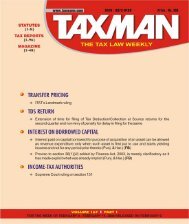CPT V24P7-Art1 (Content).pmd - Taxmann
CPT V24P7-Art1 (Content).pmd - Taxmann
CPT V24P7-Art1 (Content).pmd - Taxmann
You also want an ePaper? Increase the reach of your titles
YUMPU automatically turns print PDFs into web optimized ePapers that Google loves.
the ITAT Rules, 1946, vis-à-vis the order passed<br />
by the first appellate authority, in the following<br />
words-<br />
“When the department files an appeal for<br />
an increase in the assessed income, the<br />
subject-matter of the appeal is the increase<br />
claimed by the department and the assessee<br />
can urge any ground of defence, even<br />
though it might have been rejected by the<br />
Appellate Assistant Commissioner, for<br />
showing that there should be no increase.<br />
That the assessee is not liable to be assessed<br />
at all is a ground for showing that there<br />
should be no further assessment and the<br />
department’s appeal can, therefore, be<br />
resisted on this ground. There is no<br />
incongruity in maintaining the assessment<br />
order passed on the assessee and refusing<br />
to increase it on the ground that he was<br />
not liable to be assessed at all.<br />
But if the Tribunal accepts the ground of<br />
defence that the assessee was not liable<br />
to be assessed at all, it can only refuse<br />
to increase the assessed income as only<br />
that will be “an order on the appeal” by<br />
the department. Any other order such as<br />
annulling the assessment would be outside<br />
the scope of the appeal:<br />
Held, on the facts, that on a proper<br />
interpretation of the statement of the case<br />
• DT - Secs. 36(2) & 37(1)/Rule 27<br />
and the question framed what the assessee<br />
desired to argue before the Tribunal was<br />
that the assessment order itself should be<br />
quashed because the receipts were not<br />
profits at all, and this was rightly disallowed<br />
by the Tribunal.”<br />
CONCLUSION<br />
6. In the light of the detailed discussion, it<br />
becomes clear that pros and cons have to be<br />
weighed before an appeal filed by an assessee<br />
[on some point(s)] before the ITAT is withdrawn<br />
by him as the assessee would be left with no<br />
remedy on account of the fact that in the event<br />
of such withdrawal of appeal he would be<br />
divested of powers/rights to invoke rule 27<br />
of the ITAT Rules, 1963 on the same point(s),<br />
in case of need. It is always advisable to go<br />
through the facts of each case minutely before<br />
applying decided case laws to the issue(s) in<br />
hand. It is also imperative to go through the<br />
circulars issued by the Central Board of Direct<br />
Taxes from time-to-time to understand the<br />
purpose of introduction/amendment to a section<br />
or a rule. It is also necessary to understand<br />
from a decision rendered by a judicial authority<br />
as to what points have been decided by the<br />
authority and which points were not before it<br />
for adjudication?<br />
August 1 to 15, 2012 u TAXMANN’S CORPORATE PROFESSIONALS TODAY u Vol. 24 u 17<br />
•••<br />
637











![“FORM NO. 3CEB [See rule 10E] Report from an ... - Taxmann](https://img.yumpu.com/45480232/1/190x245/form-no-3ceb-see-rule-10e-report-from-an-taxmann.jpg?quality=85)





